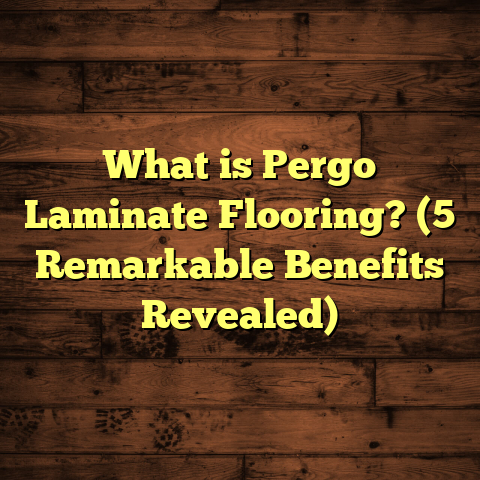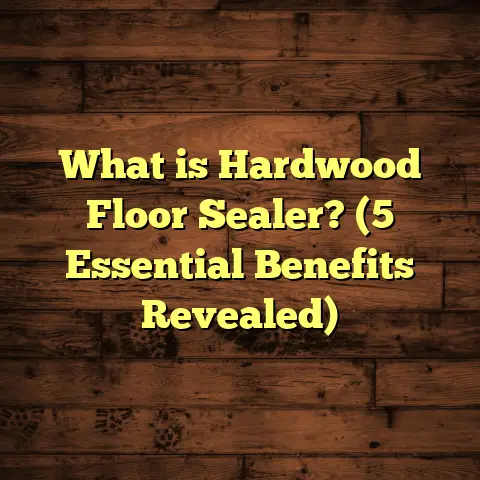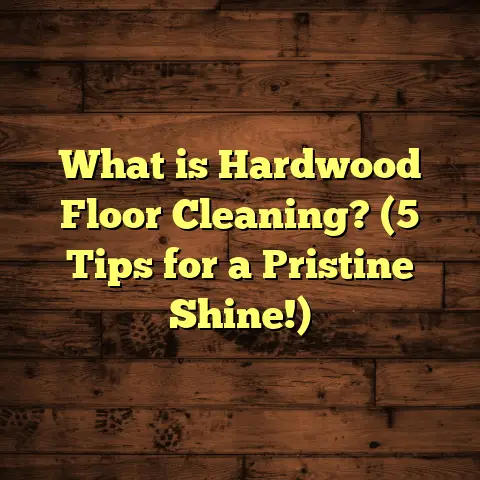What is Hardwood Plank Flooring? (5 Exceptional Benefits Revealed)
Hardwood plank flooring is one of those investments that transforms a home, not just in looks but in feel and value. I can say this with certainty because I’ve worked with countless flooring options over the years, and hardwood planks consistently stand out for their timeless charm and durability.
What Is Hardwood Plank Flooring?
Let me break it down simply: hardwood plank flooring consists of solid wood boards milled from trees like oak, maple, cherry, hickory, and walnut. These planks usually measure between 3 to 6 inches in width and can vary in length. Unlike engineered wood or laminate that have layered or synthetic cores, hardwood planks are made from a single piece of natural wood all the way through.
The appeal of hardwood plank flooring lies mostly in its authenticity. When you walk on a hardwood floor, you’re stepping on real wood. The grain patterns, knots, and natural imperfections tell a story unique to each plank. Over time, the floor develops a rich patina—a color and texture that only age and use can create. This natural aging process adds character that no other flooring type can replicate.
I often find people confuse hardwood plank flooring with other wood-like options. For example, engineered hardwood has a thin veneer of real wood on top but is backed by plywood layers or high-density fiberboard. Laminate flooring uses a photographic wood image on a resin core. Both engineered and laminate floors can mimic the look of hardwood but lack its depth and ability to be refinished multiple times.
In my experience working with these various options, hardwood planks stand out for their longevity and classic appeal. I’ve installed solid hardwood floors in historic homes that were over 100 years old and still beautiful after refinishing.
Different Types of Hardwood Plank Flooring
Before we go further, it helps to understand that hardwood plank flooring comes in several species and grades, each with distinct characteristics.
Common Wood Species for Hardwood Planks
- Oak: This is the most popular choice in North America. It’s durable, with a medium hardness (Janka rating around 1360), and has a classic grain pattern. Both red oak and white oak are widely available.
- Maple: A harder wood than oak (Janka around 1450), maple has a fine grain and lighter color. It’s often chosen for modern designs.
- Hickory: Known for its toughness (Janka around 1820), hickory has dramatic grain patterns with contrasting colors.
- Walnut: A premium choice with a rich dark brown color and softer texture (Janka about 1010). Walnut offers elegance but scratches more easily.
- Cherry: Softer than oak or maple (Janka about 950), cherry darkens beautifully over time and is prized for its warm reddish hues.
Grades of Hardwood Planks
- Select or Clear Grade: Minimal knots or imperfections, very clean appearance.
- Common or Rustic Grade: More knots, mineral streaks, and color variation—this gives floors a more natural, lived-in look.
- Character Grade: Heavy character marks, knots, splits that add rustic charm.
Choosing the right species and grade depends on your style preference and how much wear your floor will endure.
What Sets Hardwood Plank Flooring Apart from Other Flooring Types?
I’ve installed many other floor types—laminate, vinyl plank, tile, carpet—and each has pros and cons. Here’s how hardwood plank flooring compares.
Durability & Lifespan
Hardwood plank floors are incredibly durable when cared for properly. They can last 50+ years or even longer because they can be sanded and refinished multiple times to remove surface scratches or dents.
Laminate floors are tough against scratches but can’t be refinished once damaged. Engineered wood floors have limited sanding life due to their thin veneer layer. Vinyl and tile are durable but lack the warmth of wood.
Aesthetic Appeal
Hardwood’s natural grain and texture bring warmth and character to any space. Laminate tries to copy this but often looks flat or artificial close up.
Tile provides versatility in patterns but can feel cold underfoot.
Carpet adds softness but traps dust and allergens—something I’ve seen clients move away from after experiencing hardwood’s hypoallergenic benefits.
Maintenance & Cleaning
Hardwood requires regular sweeping or vacuuming to keep dirt off the surface. Occasional damp mopping with the right cleaner keeps it looking fresh.
Laminate cleans easily but can’t handle standing water. Carpet needs regular deep cleaning to avoid staining.
Vinyl is low maintenance but may fade over time in direct sunlight.
Cost Considerations
Hardwood plank flooring installation ranges widely based on species, finish, and labor rates—from $8 to $15+ per square foot on average.
Laminate is often cheaper upfront ($2-$5 per square foot) but may require replacement sooner.
Tile varies widely depending on material but can be costly to install.
My advice? Think long-term value over initial cost. Hardwood holds its worth better than most alternatives.
Five Exceptional Benefits of Hardwood Plank Flooring
Now let me share five benefits that make hardwood plank flooring my top recommendation for many clients.
1. Timeless Beauty That Never Goes Out of Style
I’ve seen trends come and go in interior design, but hardwood floors remain a constant favorite. Their natural beauty works with everything from traditional to contemporary settings.
One project I fondly remember was a Victorian-era home restoration where the owners wanted to preserve history yet refresh the space. We used wide plank oak floors finished with a warm honey tone. The result was stunning—people often asked if the floors were original!
2. Durability That Lasts Decades
Hardwood’s strength is no joke. I’ve helped families who installed hardwood floors decades ago still enjoy them today after periodic refinishing.
The Janka hardness scale rates wood species’ resistance to denting—the higher the number, the harder the wood. Hickory scores at 1820; white oak at 1360; maple at 1450; walnut at 1010; cherry at 950. These numbers translate into real-world durability differences.
If you have pets or kids, choosing a harder wood like hickory or oak can mean fewer scratches and longer-lasting beauty.
3. Improved Indoor Air Quality
Have you ever noticed how dust seems to accumulate endlessly on carpets? Hardwood plank floors do not trap dust, pollen, or pet dander like carpets do.
A client with severe allergies told me switching from carpeted bedrooms to hardwood floors dramatically improved breathing comfort for their family.
The National Wood Flooring Association points out that hardwood is one of the best flooring choices for reducing indoor allergens.
4. Easy Maintenance and Cleaning
Let’s be honest—no one wants complicated cleaning routines. Hardwood floors are simple to maintain with basic sweeping and occasional mopping with wood-safe products.
I advise clients to avoid harsh chemicals or excessive water which can damage finishes. Regular maintenance extends the life of your floor’s finish layer as well as the wood underneath.
5. Increases Home Value
This is something I’ve witnessed firsthand while consulting homeowners preparing to sell. Hardwood floors consistently attract buyers willing to pay more.
According to Remodeling Magazine’s Cost vs Value Report 2024, hardwood flooring upgrades return about 70-80% of their cost during resale—making them a smart investment financially.
Personal Stories From My Hardwood Flooring Projects
I want to share some personal experiences that highlight why I love working with hardwood plank flooring so much.
The Hickory Floor That Stole Hearts
A family once hired me to install hickory planks in their newly built home. They wanted a floor that could handle their energetic kids and pets but also look stylish.
Hickory’s varied grain gave their living room floor an almost hand-crafted feel. Months later, they told me how much they appreciated its toughness—it held up beautifully despite endless foot traffic and even some accidental spills.
The Walnut Elegance Upgrade
Another memorable job involved installing walnut flooring in a downtown loft renovation. Walnut is softer than hickory or oak but offers rich color depth that adds sophistication.
The owners chose a matte finish which helped hide minor scratches while giving the loft an upscale vibe. They said guests often commented on how luxurious the floors felt underfoot.
Matte vs Glossy Finish Debate
I often get asked about finish types—matte versus glossy. One couple couldn’t decide which look fit their style better.
We brought samples to their home so they could see how light reflected differently throughout the day. Matte finishes tend to hide imperfections better but look less shiny; glossy finishes offer sparkle but show scratches more easily.
They went with matte because of the practical benefits for their busy household with little kids.
Data-Backed Insights on Hardwood Floor Performance
To back up what I’ve seen firsthand, here are some key data points:
| Wood Species | Janka Hardness | Average Cost per Sq Ft (Materials + Installation) | Typical Lifespan (Years) | Sand & Refinish Cycles |
|---|---|---|---|---|
| Hickory | 1820 | $10 – $15 | 50+ | Up to 10 |
| White Oak | 1360 | $8 – $14 | 50+ | Up to 10 |
| Maple | 1450 | $9 – $13 | 50+ | Up to 10 |
| Walnut | 1010 | $12 – $18 | 40-50 | Up to 6 |
| Cherry | 950 | $11 – $16 | 40-50 | Up to 6 |
- The Janka hardness scale measures resistance to denting.
- Cost varies based on location, species availability, finish types.
- Lifespan depends on care but generally exceeds other flooring materials.
- Sanding cycles vary by thickness of planks and species hardness.
Environmental Considerations: Sustainability of Hardwood Flooring
You might wonder about the environmental impact of choosing hardwood plank flooring. It’s fair to ask: is harvesting trees for flooring sustainable?
Many manufacturers source wood from responsibly managed forests certified by organizations like the Forest Stewardship Council (FSC). FSC-certified wood ensures trees are harvested with minimal ecological disturbance, supporting forest regeneration and biodiversity.
Plus, wood is renewable when managed well—it stores carbon during its growth phase, helping offset greenhouse gas emissions compared to synthetic materials like vinyl.
I always encourage clients interested in “green” building materials to look for FSC-certified hardwood products or reclaimed wood options which reuse existing timber without cutting new trees.
The Installation Process: What I’ve Learned Over Time
Installing hardwood plank flooring takes skill and attention to detail—something I’ve refined through years of hands-on work.
Subfloor Preparation
The foundation must be clean, flat, dry, and structurally sound before installation begins. Any imperfections here affect how the floor lays down later.
I’ve seen cases where poor prep led to squeaky floors or uneven boards—a real headache post-installation.
Acclimation Period
Wood expands and contracts based on moisture levels in its environment. To reduce problems like gaps or buckling later on, I always recommend acclimating hardwood planks in the installation space for at least 3-5 days prior.
This step allows the wood to adjust to temperature and humidity conditions inside your home before being permanently fixed in place.
Installation Methods
Common methods include:
- Nail Down: Traditional method using nails or staples into a wooden subfloor.
- Glue Down: Adhesive applied directly onto concrete slabs.
- Floating: Planks lock together without fastening; used mainly for engineered wood.
For solid hardwood planks over wood subfloors, nail down remains my go-to because it creates a secure attachment and authentic feel underfoot.
Finishing Touches
After installation comes sanding (if unfinished), staining (optional), and sealing with polyurethane coats for protection.
I sometimes recommend site-finished floors for custom looks but factory-finished prefinished planks speed up installation with less mess at home.
How FloorTally Helps Me Manage Costs
One challenge every contractor faces is accurately estimating project costs upfront without surprises later on. When I first started out, this meant juggling spreadsheets, calling suppliers for quotes, and guessing labor hours based on experience.
FloorTally changed all that for me by providing an easy way to input room dimensions, select species, finishes, local labor rates—and get detailed cost estimates instantly.
It also factors in waste—typically around 5-10% extra material—to cover cutting mistakes or damaged planks during installation so I don’t under-order materials.
For example: A client wanted solid oak planks in their living room measuring roughly 400 square feet. Using FloorTally saved me hours by quickly generating cost estimates for material plus labor based on current market prices near their location.
This transparency helped my client budget confidently without worrying about hidden costs popping up later.
Addressing Common Concerns About Hardwood Plank Flooring
Let me address some questions I hear frequently from homeowners considering hardwood floors:
Will Hardwood Floors Scratch Easily?
Yes, all wood floors can scratch from heavy furniture or pet nails—but harder species like hickory or oak resist scratching better than softer woods like cherry or walnut.
Using area rugs in high-traffic zones plus furniture pads helps protect your floor’s surface too.
Are Hardwood Floors Slippery?
Not necessarily—it depends on finish type. Matte finishes have more grip compared to glossy polyurethane coatings which can feel slick when wet.
Can Hardwood Be Used in Kitchens or Bathrooms?
Kitchens? Absolutely—if sealed well they handle typical spills fine. Bathrooms? Generally not recommended due to high moisture levels unless you choose engineered wood designed specifically for wet areas.
How Often Will I Need To Refinish?
Most people refinish every 7-10 years depending on wear patterns. High traffic areas may require more frequent attention while less-used rooms can go longer between sanding cycles.
Exploring Design Trends With Hardwood Plank Floors
I love seeing how homeowners personalize hardwood floors to suit their tastes:
- Wide Plank Floors: Wider boards (5”–7”) create spaciousness and highlight wood grain beautifully.
- Mixed Width Floors: Using several plank widths randomly adds visual interest.
- Hand-Scraped or Distressed Finishes: These mimic aged wood surfaces giving rustic charm.
- Unfinished Floors: Some choose unfinished planks so they can apply custom stains themselves.
- Color Choices: From natural blonde tones to rich espresso stains—there’s a shade for everyone’s aesthetic preference.
In one recent project, we used white oak planks stained in a subtle gray wash paired with matte finish in a coastal home design. It looked modern yet cozy—clients were thrilled how versatile hardwood could be with finishes alone.
Wrapping Up My Take on Hardwood Plank Flooring
Choosing hardwood plank flooring is more than just picking a surface—it’s deciding on an element that shapes your home’s atmosphere for years ahead.
The combination of authentic beauty, durability, easy maintenance, health benefits, and value appreciation makes it a standout choice from all other flooring options I’ve worked with over time.
If you’re thinking about upgrading your floors soon, consider what fits your lifestyle best regarding species hardness, finish style, budget range—and don’t hesitate to reach out if you want tailored advice based on your unique needs!
Got questions? Curious about species comparisons? Wondering how costs might stack up locally? Just ask—I’m here to help you make smart choices that you’ll love walking on every day!





